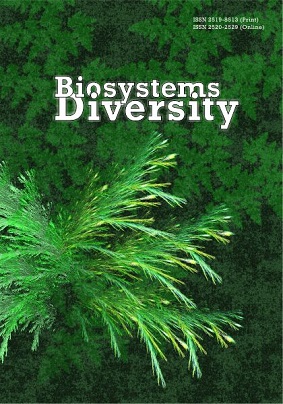Morpho-ecological structure of oribatid mite (Acariformes, Oribatida) communities in the forest litter of recultivated areas
Morpho-ecological structure of oribatid mite (Acariformes, Oribatida) communities in the forest litter of recultivated areas
Author(s): Y. Kulbachko, O. Didur, N. Khromykh, A. P. Pokhylenko, T. Lykholat, B. LevchenkoSubject(s): Agriculture, Energy and Environmental Studies, Human Ecology, Environmental interactions
Published by: Дніпропетровський національний університет імені Олеся Гончара
Keywords: environment rehabilitation; ecosystem services; forest recultivation; red juniper; Juniperus virginiana;
Summary/Abstract: The study of morpho-ecological organization of oribatid mite communities (Acariformes, Oribatida) inhabiting forest litter of recultivated areas in steppe zone conditions of Ukraine was performed. The role of the forest and forest floor litter in optimization of the ecological situation on degraded lands was demonstrated. The function of environment creation by oribatids, as primary destructors of dead plant matter, supporting such ecosystem services as soil fertility improvement and nutrients turnover was highlighted. The research was performed within different stratigraphic types of bulk edaphotops in the recultivated plot of “Pavlogradskaya” colliery (Pavlograd, Dnipropetrovsk region, Ukraine) planted with red juniper (Juniperus virginiana L.). Withdrawal and collection of mites was performed with thermoeclector. For determination of the domination structure in the mite communities, the Engelmann scale was used. Adaptive (morpho-ecological) groups of oribatid mites were diagnosed by Krivolutsky. It was established that the number of species of oribatid mites in the forest litter of the studied red juniper plantation varied from 16 to 25. Average density of oribatid mites varied from 4,720 to 25,327 ind./m2 . Among such morpho-ecological groups as soil surface inhabitants, small soil pore inhabitants, deep soil forms, floor litter inhabitants and unspecified forms, identified in the coniferous litter, the share of unspecified forms increased from loess-like loam type (21% of total amount) to Calcic Chernozem types with different stratigraphy (41.0%, 70.0% and 70.4% accordingly). Deep soil forms in the forest floor litter of the studied red juniper plots were not identified for any of recultivation types. The obtained results expand our understanding of the role of oribatid mites in the processes of ecological rehabilitation of disturbed ecosystems in the conditions of modern nature management.
Journal: Biosystems Diversity
- Issue Year: 27/2019
- Issue No: 4
- Page Range: 334-341
- Page Count: 8
- Language: English

